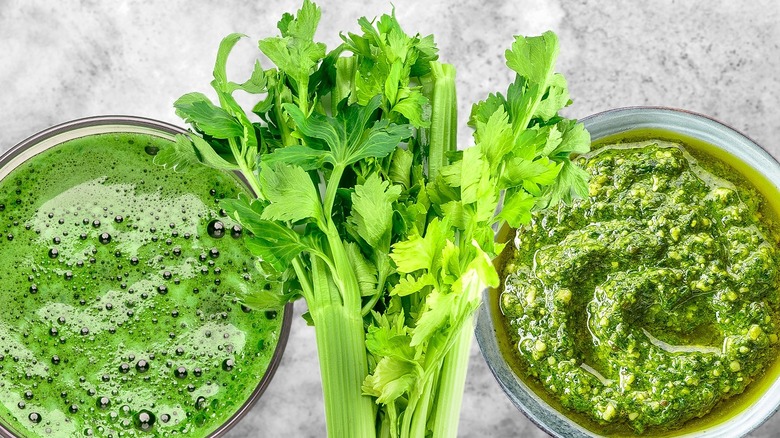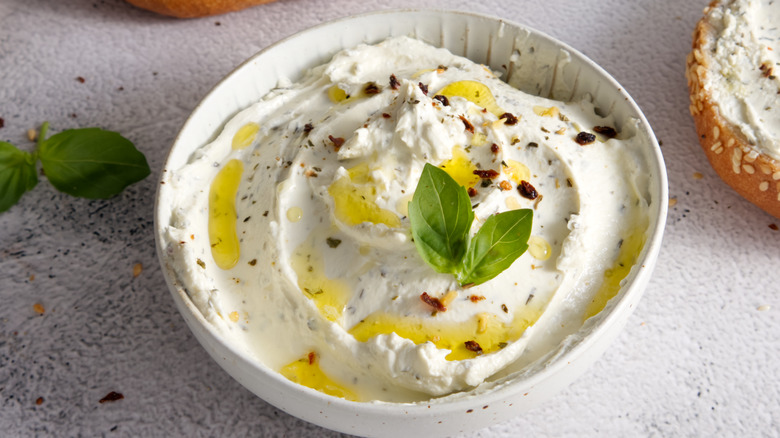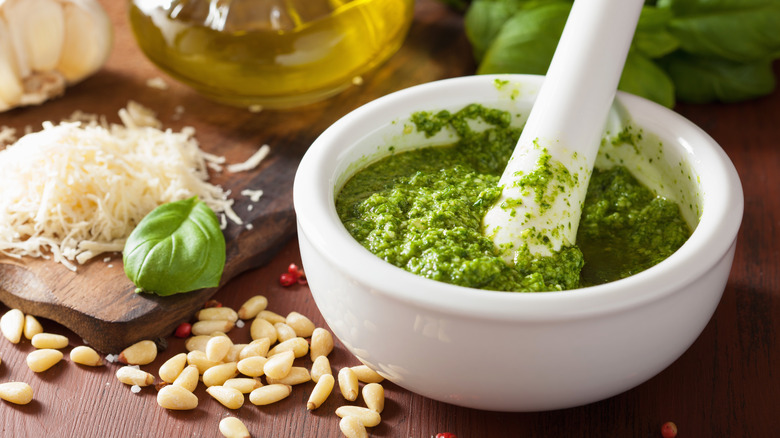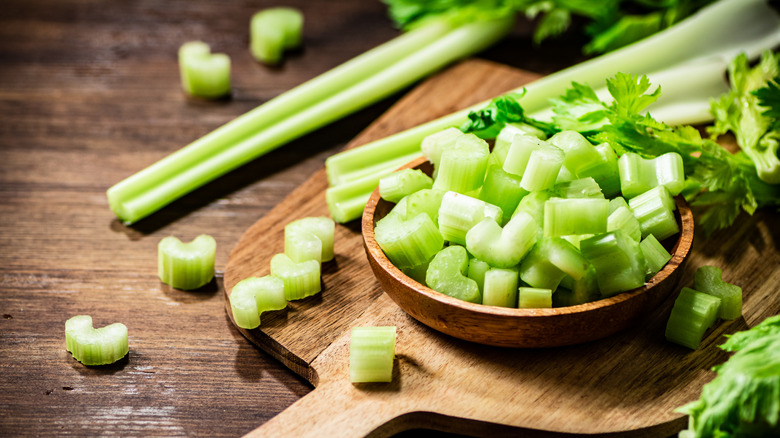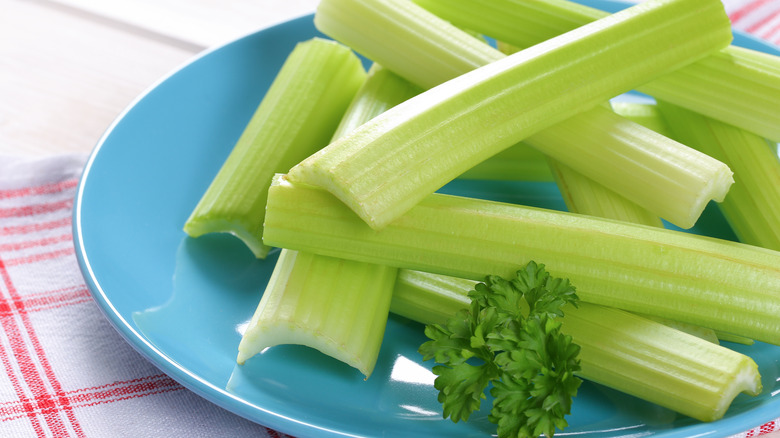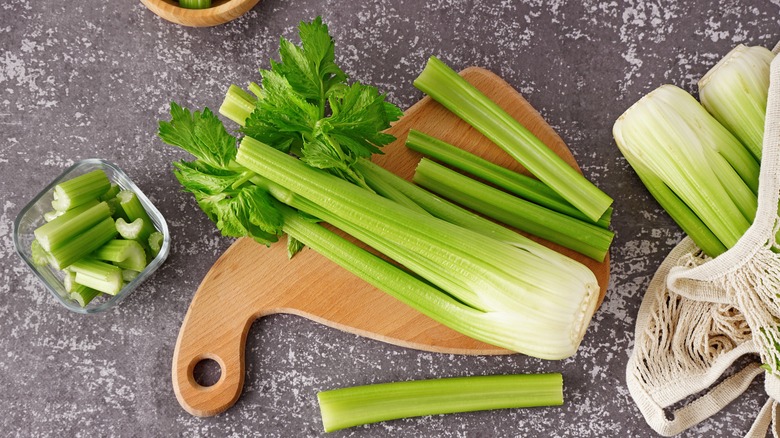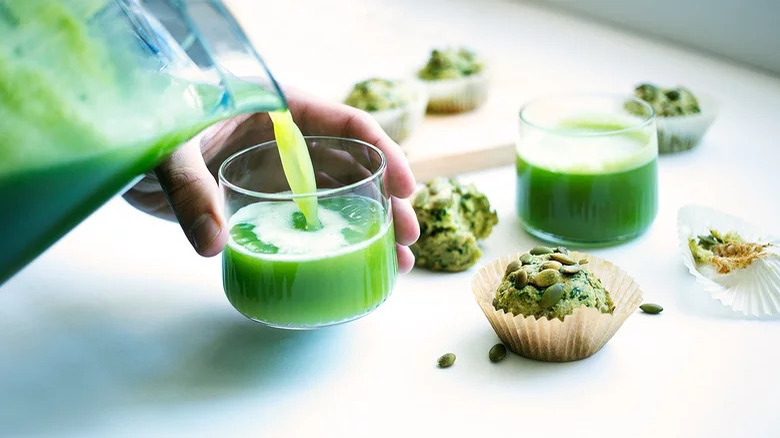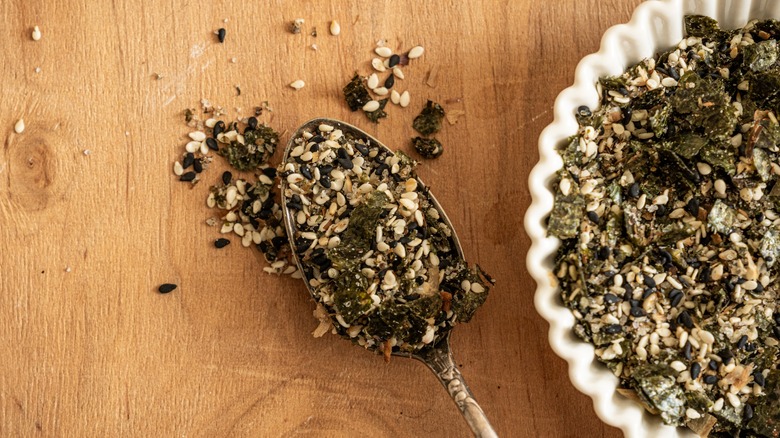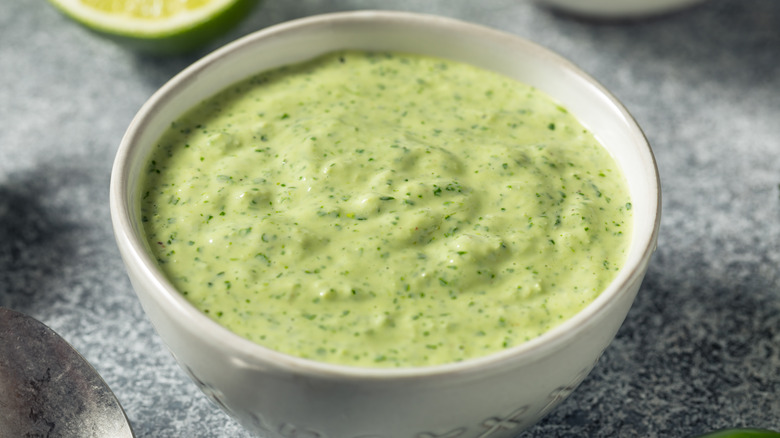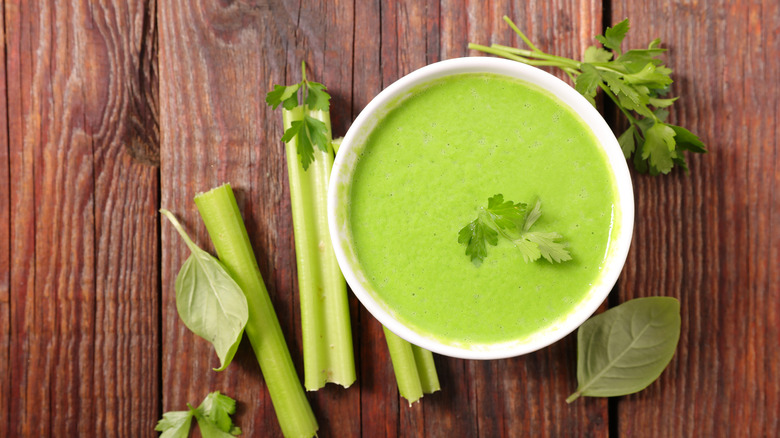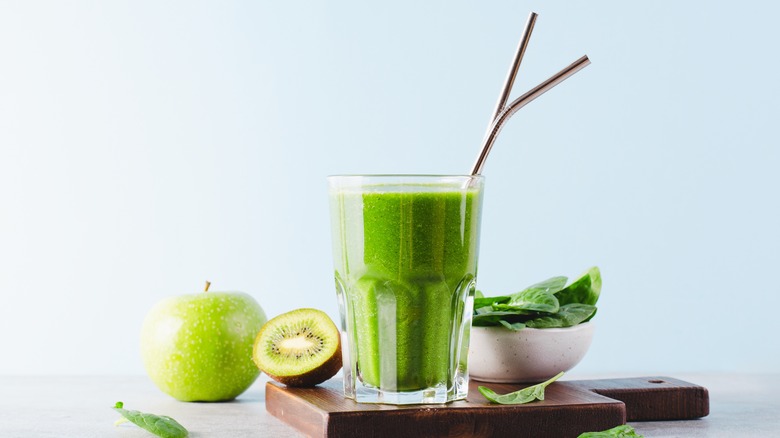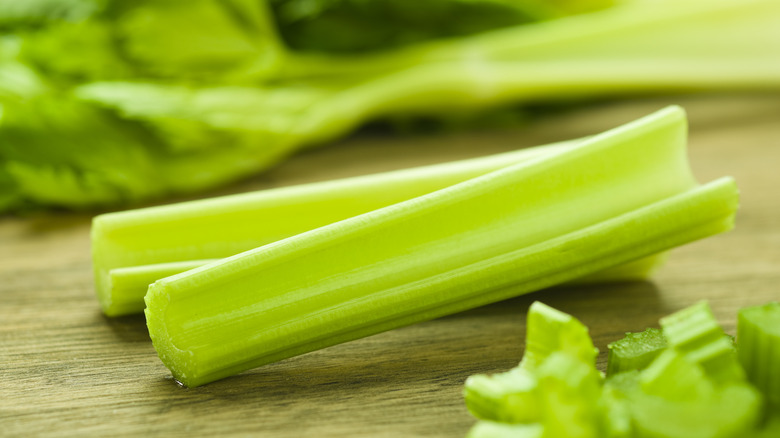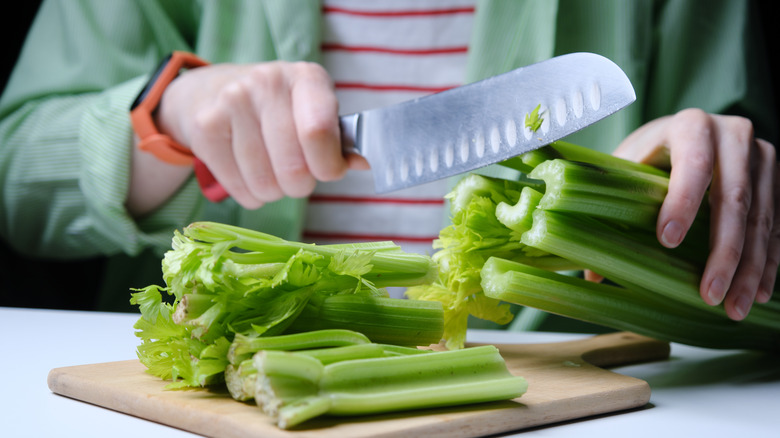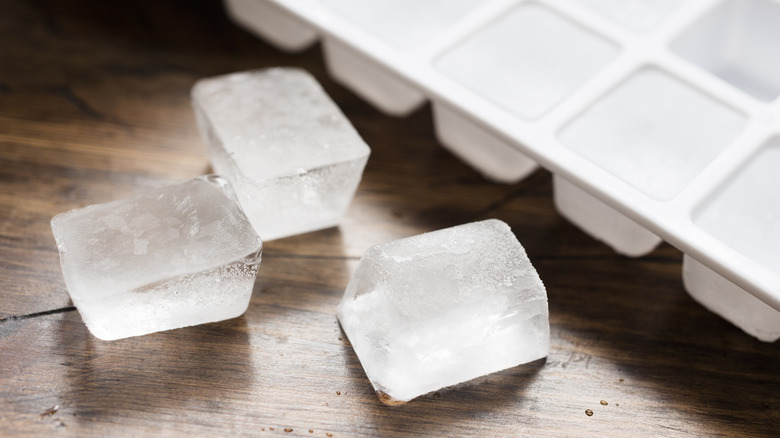14 Creative Ways To Eat Celery
From homemade soups to vegetable platters, there are so many dishes that call for celery. Yet many people think the vegetable is boring or plain, thanks to its super mild flavor and high water content. If you're in the anti-celery boat, these creative ways to eat celery might just change your mind. With a bit of innovation and a willingness to incorporate unexpected ingredients, you can transform the vegetable into savory main dishes, creamy condiments, and even healthy baked goods.
Plus, by exploring unique ways to eat and cook celery, you'll be able to take advantage of its impressive nutritional profile. Since the vegetable is made of 95% water, it's low in calories, making it a light and hydrating treat. It also contains essential nutrients like vitamin C, which helps rebuild your body's tissues, and potassium, which regulates blood pressure and helps your muscles and nerves function.
To make sure your celery recipe is a success, look for stalks with a light green color and fresh, crisp leaves. Avoid celery that's mushy, bruised, or limp, which are all signs that the vegetable is on its way out. At home, store celery in a plastic bag, preferably in the crisper drawer at the bottom of the refrigerator; this will keep the vegetable at the right humidity it needs to stay fresh. For the best quality, use celery within one to two weeks — but with these clever celery ideas in your repertoire, you'll have no problem using the vegetable even sooner.
Stuff it with cream cheese
There are few snacks more nostalgic than peanut butter-stuffed celery sticks; extra points if you add raisins on top to make ants on the log. But why stop at peanut butter? For a grown-up riff on the classic snack, fill celery sticks with cream cheese instead. The plain kind is a delicious option, especially if you're looking for a treat that calls for minimal effort.
If you have a few minutes to spare, consider seasoning your cream cheese first. It's an easy way to add more flavor and customize the dish. To start, soften cream cheese by leaving it out at room temperature or dunking it in a hot water bath. This will ensure it's malleable enough to mix in a bowl, allowing your seasonings to become evenly incorporated. From there, combine the cream cheese with additives of your choice, like poppy seeds, chives, harissa, honey, or rosemary, then spread the mixture on top of celery sticks.
Since celery has a mild flavor, it will pair well with many types of seasonings. Try stuffing celery sticks with garlic cream cheese for a burst of savory goodness, or add some heat with chili powder, red pepper flakes, or paprika. In either scenario, the result will be a side dish or appetizer that's perfect for last-minute party planning.
Serve celery with hot sauce
Celery is naturally refreshing and cooling thanks to its high water content. This makes it the perfect partner for hot sauce, which adds a kick of heat. To keep it simple, drizzle a bit of hot sauce on a celery stalk before eating it. Alternatively, if your taste buds can take it, you can dunk celery directly into hot sauce.
If you want to take it up a notch, mix hot sauce with another condiment before enjoying it with celery. Sour cream and mayonnaise are ideal for balancing the heat, while Greek yogurt offers a satisfying tang plus protein. Other flavorful options include ranch dressing, blue cheese dressing, hummus, and guacamole.
When matching up kitchen soulmates hot sauce and celery, consider unconventional varieties as well. For example, mango habanero hot sauce will provide a hint of tropical sweetness, while our recipe for schug packs a ton of heat thanks to 20 (yes, 20) serrano chiles.
Blend celery leaves into pesto
Basil may be the star of traditional pesto, but it's not your only option. Switch up the condiment by using celery leaves, which boast a bitter, earthy, and grassy flavor with a hint of sweetness, or use half-and-half basil and celery leaves. These elements will add a unique depth to your dishes, especially when paired with salty or savory ingredients like pizza or tomato salad. By saving celery leaves to make pesto, you can reduce food waste and get the most out of your produce.
To make celery leaf pesto, you can follow the steps for your favorite homemade pesto recipe; simply replace some or all of the basil with celery leaves. If you don't have enough celery leaves, other herbs like parsley and mint work well in concert with it. Add the leaves to a food processor, along with the classic pesto ingredients like fresh garlic, Parmesan cheese, and lemon zest. Blitz until combined, then add olive oil and puree for a few minutes. Enjoy your celery leaf pesto just like you would regular pesto: tossed with pasta, on a pizza, on top of scrambled eggs, or spread on a sandwich.
Make a celery salad base
Chop up celery for a salad base for another way of using this crunchy vegetable. After all, salads aren't limited to leafy greens, and celery offers a texture that's excellent for switching things up. What's more, you can incorporate the random pieces leftover after chopping up celery for charcuterie boards or veggie platters. This includes the white bottom of a celery heart, which is usually tossed. Just be sure to cut off the root portion, then chop the remaining white parts.
The trick to making a delicious celery salad is to use a creamy, flavorful dressing, like a homemade coleslaw dressing. The richness of the condiment will balance the crispness of the celery, making it super satisfying to eat. While you're at it, consider incorporating ingredients of contrasting textures, such as feta cheese, dried cranberries, and shredded rotisserie chicken. If you really love your celery, though, you can let it shine solo. Chop everything from the white bits to the leaves and add it together in one big celery salad, topped with oil and vinegar and a good dash of salt and pepper.
Pickle celery stalks
If you love pickled vegetables, try quick-pickling celery stalks. It's a great way to use up leftover celery stalks or, if you have too much on hand, prevent celery from going bad in the fridge. All you need to do is place celery in a jar, add a saltwater brine, and secure an airtight lid. Store the jar in the fridge for at least 15 minutes, and you'll have a salty and crunchy treat.
When cut into stalks, quick-pickled celery makes for an excellent snack or side dish. However, you can also cut the celery into thin slices, matchsticks, or diced pieces before pickling it. These options will allow you to incorporate the vegetable into salads, sandwiches, barbecue platters, or even creamy sauces, just as you would use sweet pickle relish in homemade Thousand Island dressing. Regardless of how you prepare the celery, it will last one to two weeks in the fridge after being quick pickled, so you'll have plenty of opportunities to enjoy it.
Roast celery
Roasting celery might seem like an unusual way to prepare it. But when the technique is done correctly, it can tone down the celery's bitterness while making it sweet and soft. This is especially helpful if you're not a fan of raw celery or if you're looking for an interesting way to cook it beyond using it for broth.
There are several ways to roast celery. One option is to cut off the tops and leaves of a celery bunch, then slice it in half lengthwise. Brush olive oil onto each half, then sprinkle with salt, pepper, and other seasonings like garlic powder or dried herbs. Place the celery halves, flat side down, on a baking sheet lined with parchment paper, then roast until cooked through. Alternatively, you can chop the celery into bite-sized pieces before tossing it with olive oil. Stir the celery halfway through the roasting process, then toss with a light vinaigrette for a simple side dish.
Add celery pulp to muffins
If you regularly make green juice, there's a good chance that celery is a staple in your refrigerator. Instead of tossing the pulp leftover from the juicing process, consider saving it in and using it in muffins. Not only is the pulp packed with fiber and vitamins, but it's tasty too. The trick, of course, is to use it in a way that highlights these features — and adding it to a muffin batter will do just that.
For this hack, you can use celery pulp on its own or with other vegetables. If you only want to use celery pulp, start by juicing the stalks before other ingredients, then remove the pulp from the juicer. Another option is to juice all of your ingredients, including celery, and use the pulp from there. This method may be more desirable in terms of flavor, as other ingredients (like apple and ginger) will balance the earthiness of celery. But take note that leftover vegetable pulp will add moisture to your muffins, so you'll likely need to reduce other liquids or increase the dry ingredients to achieve the right consistency. Another option is to follow a recipe designed to include the pulp, like our green pulp muffins.
Make kombu celery
When you think of elegant appetizers, celery stalks probably don't come to mind — but kombu celery might change that. Originating from Bar Goto, a cocktail bar in New York City, kombu celery is a simple snack made of shaved celery stalks coated in nutty sesame oil and a bit of soy sauce. The stalks are then covered in furikake, an umami Japanese seasoning made of fish flakes, dried seaweed, sesame seeds, herbs, salt, and MSG. The result is a flavor-packed snack that will make your taste buds sing.
Luckily, you don't have to trek to New York City to enjoy kombu celery, as it's easy enough to make at home in several minutes. Start by peeling the celery stalks to remove the fibrous outer layer. Drizzle sesame oil and soy sauce on the celery, then roll it in furikake seasoning. No cooking needed. Feel free to add more toasted sesame seeds for extra crunch and flavor. If you're craving some heat, add red pepper flakes to the mix.
Whisk up a celery sauce
Celery is often eaten with dips or dressings, as its crunchiness complements creamy textures. But have you ever used celery to make a condiment? Enter celery sauce, an earthy and vegetal preparation that can be enjoyed in many ways. The first step is to cook the celery until it's soft. You can do this by roasting, sautéing, or boiling the vegetable. Roasting and sautéing will bring out its natural sweetness, while boiling is ideal if you want to skip the oil. Once the celery has softened, puree it with water or broth, salt, black pepper, fresh garlic, Parmesan cheese, and any other seasonings you enjoy.
If you can't wrap your head around the idea of celery sauce, consider this: Heinz, the company that popularized tomato ketchup, offered celery sauce in the late 1800s. Celery sauce is typically served with poultry, but you can also toss it with pasta or rice or serve it on seafood, pork, or beef. Celery sauce can be even used as a dip for chips, crackers, or other vegetables like carrot sticks and red bell pepper slices.
Use it in green soup
Between its green color and grassy flavor, celery will be right at home in a warm green goddess soup. The dish offers a deliciously convenient way to eat your greens, particularly if you're not a fan of munching on salads. Since celery has a relatively mild taste, it plays well with other green vegetables and herbs like kale, spinach, zucchini, broccoli, and parsley. Be sure to add basic flavoring ingredients like garlic and lemon juice, which will help balance the earthiness of the soup.
For a summer-friendly take on this idea, make green gazpacho with celery. If you're unfamiliar with gazpacho, it's a type of soup that's meant to be eaten cold — and it's delightfully easy to make at home. All you need to do is chop up vegetables, combine it with broth or yogurt, then puree until smooth. The key to a successful gazpacho is to cut your vegetables into fine pieces, which will make blending a breeze. Our recipe includes avocado for extra creaminess and garlic for a little complexity.
Add celery to smoothies
Fresh celery is one ingredient that will upgrade your smoothies, particularly any that highlight green fruits and vegetables. The earthy, somewhat bitter flavor is ideal for toning down extra tart or sweet ingredients like raspberries, pineapple, and kiwi. It also contains some sodium, which will help amplify the natural flavors of fruits and vegetables alike. Furthermore, celery is high in water, so it will make your smoothie even more hydrating.
When using celery in your smoothies, avoid tossing a stalk in your blender and calling it a day. Whole stalks can damage the blades of your blender, so be sure to chop it into smaller pieces first. Also, the vegetable is quite fibrous, so take your time when blending a smoothie made with celery. This will ensure the outer stringy parts are fully broken down and don't get stuck in your teeth. Or if you have a few minutes to spare, you can peel the celery stalks to remove the outer layer.
Top dishes with shredded celery
Reach for celery the next time your dish needs a boost of flavor or texture. You can shred the vegetable with a peeler, then roughly chop it up to make "sprinkles." If you prefer to use a grater, consider freezing the celery stalks and grate them just before adding it to food. This will help the vegetable keep its shape when you grate it and not turn to pulp.
Use shredded or grated celery just like you would fresh herbs. Try it on top of deviled eggs, where the refreshing consistency and coolness of celery will contrast beautifully with the creamy yolk filling. You can also sprinkle shredded celery on salads, avocado toast, pasta, or casseroles just before digging in. Note that fresh celery leaves can also be used in a similar way, so be sure to hold on to them when cutting the vegetable.
Bake celery gratin
Potato gratin is delicious, but let's face it — the dish is extremely rich and heavy. If you're looking for a lighter version, consider substituting celery for potatoes. By using celery, you'll be able to enjoy a less starchy dish without sacrificing the same creamy, cheesy goodness you know and love from potato gratin. Plus, celery will become soft and sweet in the oven, so it will be just as satisfying as the classic kind. You can make it with celery sticks or finely sliced celery, the latter of which will yield a more scoopable dish. You can even add celery to a regular potato gratin recipe to try it out.
If you want to bulk up celery gratin without making it too rich, try adding chunks of ham to the dish. Otherwise, you can enjoy it as for a vegetable appetizer. Serve it with roasted chicken, grilled cheese, pork chops, or lentil stew. Celery gratin also makes a tasty side dish for pasta, whereas the potato kind might be too starchy to use for this purpose.
Freeze celery into ice cubes
Whether you're mixing up a cocktail or sipping on plain water, ice cubes are a must for keeping cold drinks cool. But why stick to plain and boring ice cubes? Spruce up your next batch by combining water and diced celery in ice cube trays, then freezing everything until solid. The celery ice cubes can be used in cocktails, green juice, seltzer, lemonade, or plain water, where they'll add a splash of color and flavor.
Celery-studded ice cubes work best with refreshing ingredients, as they'll complement the flavors of celery. Examples include cucumber-infused vodka or cucumber water; both beverages have a light, slightly sweet flavor due to the addition of cucumber. Drinks that contain mint, thyme, and lemon are great candidates as well. When made with just water and celery, the ice cubes can even be used in cooked recipes. For instance, if you're cooking pasta, rice, or quinoa, add several celery ice cubes to the pot just before the grain is cooked. The water will quickly melt and become absorbed into the grain, allowing the celery to become heated through.
